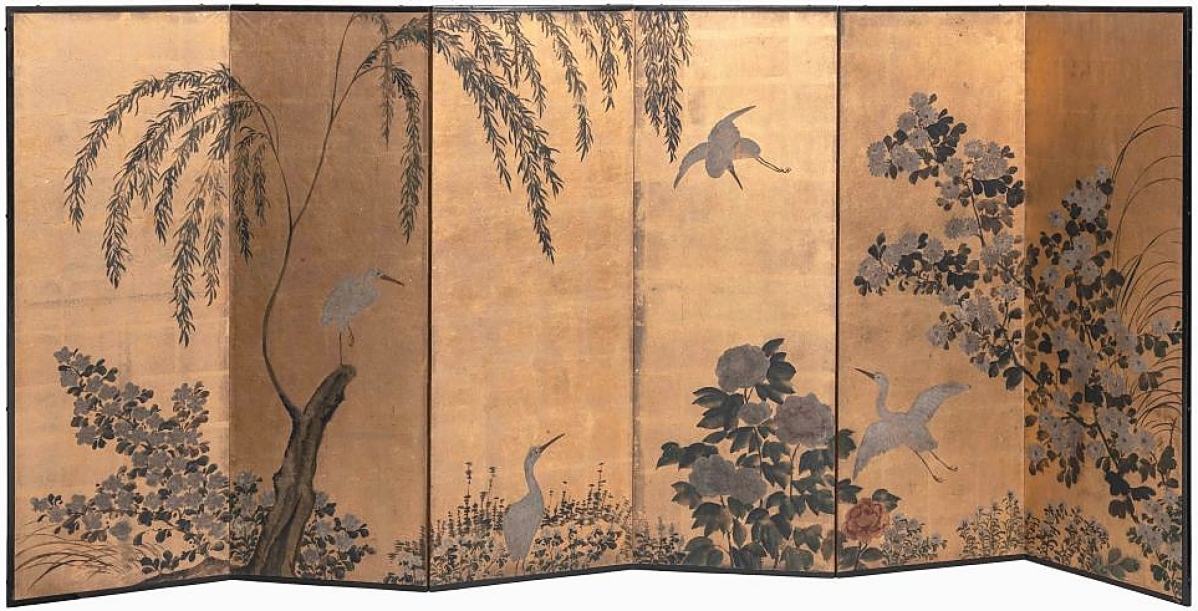
Topping Japanese works of art in any of the three sessions of sales was this Meiji period six-panel screen, depicting cranes in a landscape in ink, color and gold leaf. It flew to $7,500 where it was bagged by a private collector in New York City who was bidding by phone ($1/2,000).
Review by Madelia Hickman Ring, Catalog Photos Courtesy Eldred’s
EAST DENNIS, MASS. – The annual calendars of collectors of Asian antiques and works of art are often busy with Asia Week events taking place in and around New York City during March and September. A farther-flung venue should be added to the roster, with Eldred’s Auctions conducting its twice-annual Asian Art sales similarly timed. In a three-day sale conducted live-online March 17-19, the Cape Cod firm offered exactly 900 lots that achieved a total of slightly more than $517,000 with buyers from the United States and another 18 international countries.
“We wanted to hit $400,000 and were pleasantly surprised. The Asian market has been a little soft and we were encouraged with how well it did,” Eldred’s director of Asian works, Annie Lejoie, said a few days after the final gavel fell. “We had some really nice things from private sources, both locally and from New England, that were fresh to the market and attracted a lot of attention. I was also excited to see several of the top lots from the three-day sale were Japanese, and that Japanese material garnered stronger prices than we’ve seen in recent years.”
Lejoie said that interest in the Japanese antiques came from bidders in Japan, China and the United States and thought the bump in activity and prices realized might have been a result of Eldred’s recently adding LiveAuctioneers to the online platforms that streams their sales live. “We got a lot of new bidders and buyers as a result of that,” she said.
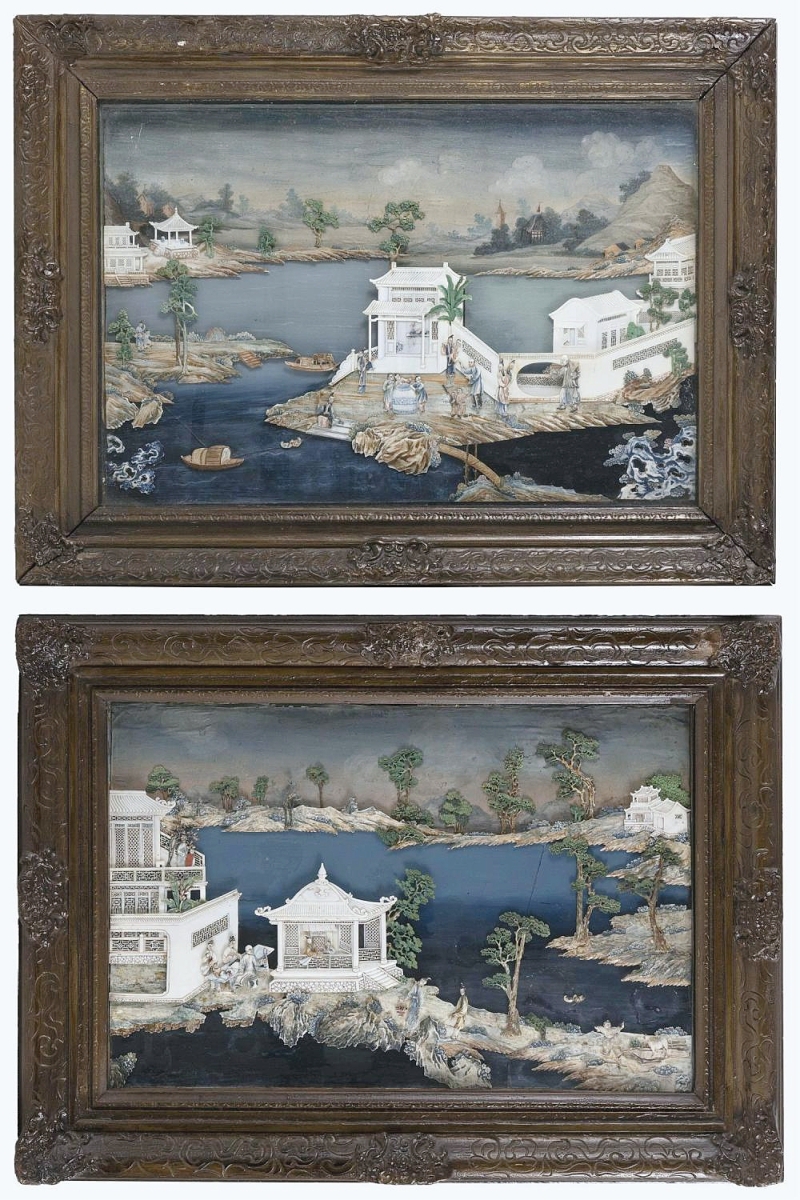
A pair of Qing dynasty Chinese painted ivory shadowbox panels realized the highest price of the three-day event, garnering $11,875 from a New York City phone bidder. The pair related to a single panel that had been offered in Hong Kong about three years ago ($10/15,000).
The top price achieved during the sales was $11,875, for a pair of Qing dynasty Chinese polychrome ivory painted shadow box panels, Qianlong period, which were housed in rosewood frames. The pair featured a layer of finely carved and stained ivory landscapes with figures in various pursuits in and around waterfront pavilions, over a painted ivory river landscape. It was being sold by a private collector in New England and was purchased by a phone bidder from New York City. The pair, which was similar to a single panel offered at Sotheby’s Hong Kong in the spring of 2018, had been offered by Eldred’s in 2020 but failed to find a buyer. With a slightly reduced estimate, Lejoie said the pair got a lot of interest and sold within expectations.
A few other lots that had failed to sell on their first foray across the block also brought strong results. A private collector in New York bought a Meiji period Japanese six-panel screen that depicted cranes in a floral landscape against a gold ground. Eldred’s had offered it in September with an estimate of $2,5/3,500 but when it did not sell, Lejoie reduced the estimate, which prompted enough interest that it flew to $7,500.
It was purely coincidental that the other Japanese screen to soar past its estimate also featured cranes and had also been offered unsuccessfully. From the Shiro Kuma Collection of Edwin and Rhena Symmes of Atlanta, GA., a six-panel example from the Edo period brought $6,875 from a private collector in Michigan who was bidding online. Another piece from the Shiro Kuma collection was a Japanese black and gold lacquer temple drum with tama-form stand that a buyer in Saint Louis beat to $2,000, four times its low estimate.
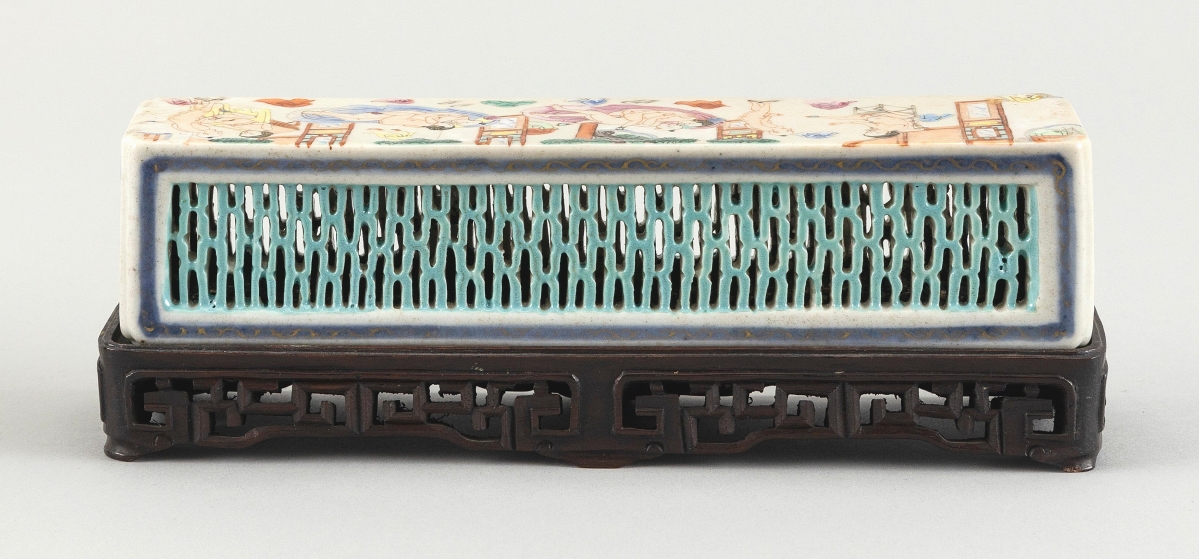
“It was a wonderful cricket cage,” Annie Lejoie said of this Nineteenth Century Chinese reticulated porcelain example that hopped its way to the second highest price of the sales, bringing $10,000 from an online buyer in California ($400/600).
A Nineteenth Century Chinese reticulated porcelain cricket cage that featured erotic scenes had been acquired at Eldred’s more than 20 years ago by a Virginia collector who cultivated a large and discerning collection of Chinese and Japanese antiques but is now downsizing. The cage brought the second highest price of the sales, achieving $10,000 from a California collector who was bidding online.
A large collection of jades and netsuke from the Midwest was headlined by a Nineteenth Century Chinese carved coral belt hook that snagged the third highest price, selling to an online bidder from New York City for $8,125. Lejoie noted that interest in jades and hardstone continues to be strong and pointed to the result achieved for an assorted group of seven carved stone items that featured six pieces of a jade carved hardstone horse. Estimated at just $200/500, the lot brought $4,063 from a buyer in China. An Eighteenth Century temple jar-form Chinese carved celadon jade covered vase received lots of interest before the sale and the result exceeded expectations, bringing five times its high estimate and selling to an online buyer from Beijing for $3,000.
A dozen lots in the first session on March 17 were property from the India House in New York City. The landmarked India House was built in lower Manhattan in the Nineteenth Century in the style of a Renaissance palazzo. It was used by several companies prior to 1921, when it became the home of the India House organization, which was founded by a group of businessmen who wanted to promote foreign trade. Today, the building houses a social club with a diverse collection of maritime, Asian and New York art; Eldred’s will sell works from the collection in its upcoming Maritime and Americana sales.
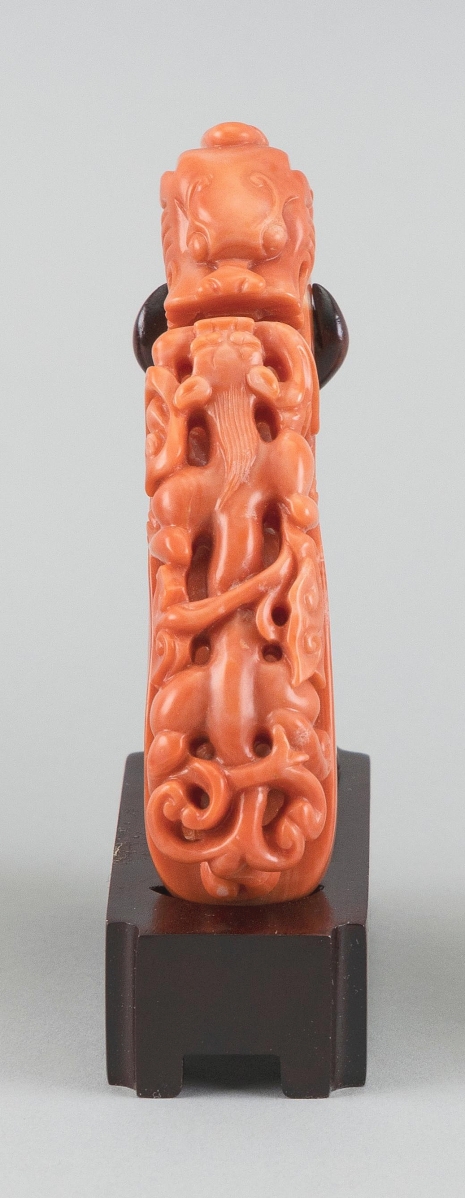
“That was exciting. I knew it would do well but still estimated it conservatively,” commented Annie Lejoie about this Nineteenth Century carved coral hook with stand and fitted box that attracted only online action. A bidder from New York City took it to $8,125 ($800-$1,000).
Offerings from India House were largely Chinese bronzes, but the group was headed by a Nineteenth Century Chinese bronze kapala that had chased dragons and deities on waves with a rim inset with coral and turquoise cabochons, all on a separate bronze openwork base with three removable deities in a rockery of trees, ruyi, deer and birds. It brought $6,875 from an online buyer in China.
Several lots are staying in Massachusetts, including a Nineteenth Century Chinese “clair de lune” porcelain brush washer, which had remnants of an old label on the base and had been consigned by a Massachusetts seller. It sold to a private collector for $6,250, well beyond its $400/600 estimate. Sourced from a Connecticut house by Eldred’s Mystic, Conn., office was a pair of Nineteenth Century Chinese doucai porcelain vases with figural decoration that had been heavily repaired. The pair were offered at just $200/300, but a buyer in Massachusetts liked them enough to take them to $1,750.
International buyers had deeper pockets than Americans for some of the other high-selling porcelain lots. A buyer from China spent $4,688, beating out competition on a late Nineteenth or early Twentieth Century Chinese Dayazhai yellow-ground porcelain vase of amphora form with salmon-red dragon’s-head handles. In addition to the four-character Yong qing chang chun marks, it had a three-character Dayazhai mark on the shoulder. Lejoie noted that the quality was very good despite its relatively recent age. A phone bidder from London spent $3,250 to acquire an Eighteenth Century Japanese polychrome porcelain ball-form teapot with Dutch gilt bird and figural mounts.
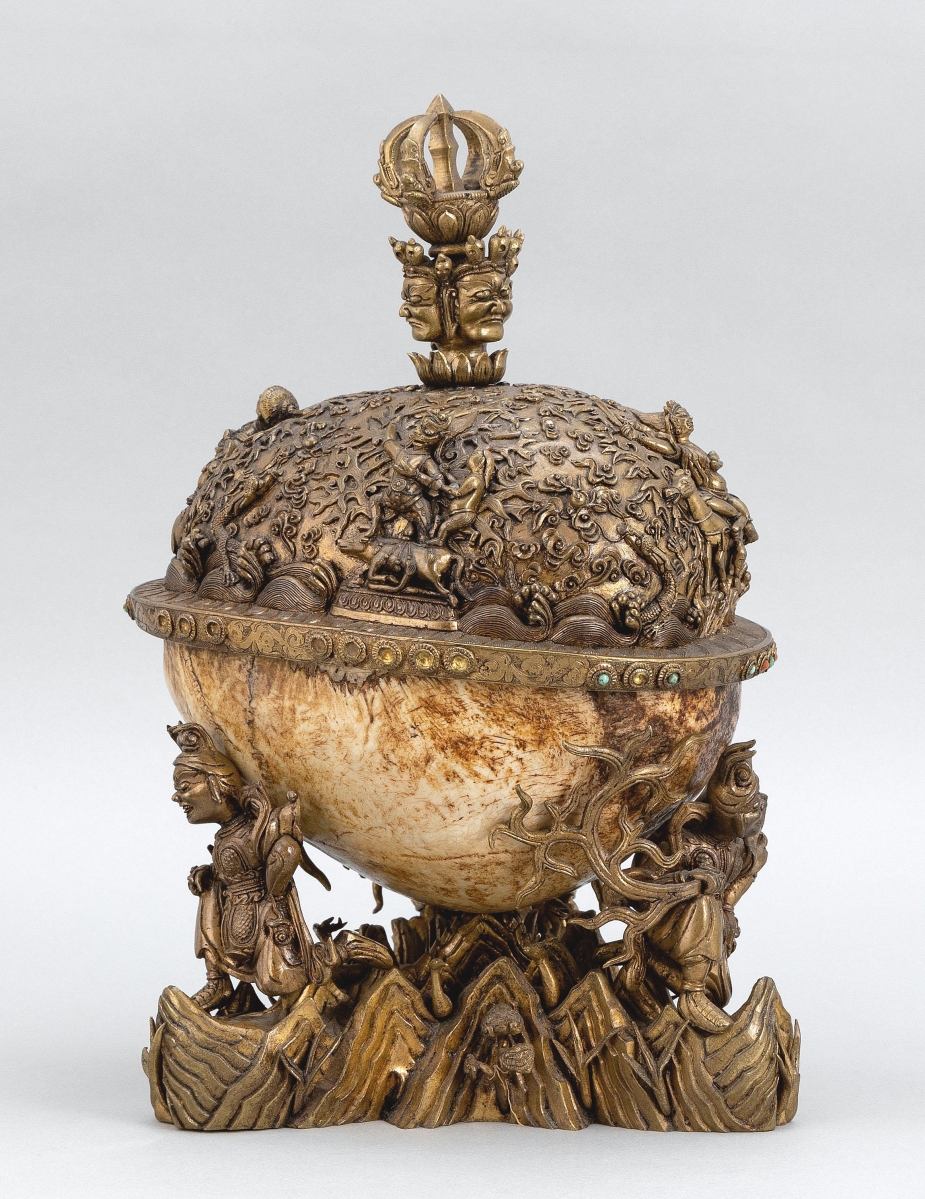
This Nineteenth Century Chinese bronze kapala headed the offering of works from the India House collection and sold to an online Chinese buyer for $6,875 ($3/5,000).
Garnering international interest was a late Meiji period Japanese mixed metal tray that featured Raijin, the Shinto god of thunder and lightning in raised decoration. Lejoie said it had come from a local house “just down the road,” and it was unmarked. She thought it was “a really nice piece” and was unsurprised that it brought several times its estimate, selling to an online buyer from Austria, for $1,875. Another piece that was sourced locally and will be leaving the country was a Shen Shai an Shoon Kee gilt-lacquered tray of leaf form that was stamped “Foochow China” on its base. It measured 17 by 12 inches and sold to an online buyer in Canada for $5,000.
Lejoie said that the most asked-about item in the sale was a watch fob made of four Meiji period Japanese ojime. It measured 5¼ inches and had an estimate of $500-$1,000 but interest brought a stellar result of $3,750 from a Massachusetts buyer bidding online who beat out competition online and on the phones. Cranes decorated the largest ojime, which was of solid gold and had a character mark; the others were unmarked gold over copper. It was one of a half-dozen lots that had descended in the family of Woodbridge Bingham (1901-1986), who was a professor of East Asian history at the University of California, Berkeley and who was the son of Hiram Bingham III (1875-1956), who rediscovered Machu Picchu.
The Bingham collection featured three lots of Mongolian jewelry that also attracted attention. The best of these was a coral, turquoise, glass, enamel, silver and white metal necklace that measured 41 inches in length. Bearing an estimate of just $300/500, it sold for $2,500. Another necklace – this measuring 39 inches and made of coral, turquoise, malachite, glass and silver – finished at $563. A lot of three pieces of Mongolian jewelry made up of a cuff bracelet with coral and turquoise, a coral ring and a lapis lazuli ring ran to $813. All of the lots of Mongolian jewelry were purchased by the same new buyer in Switzerland, who was bidding online.
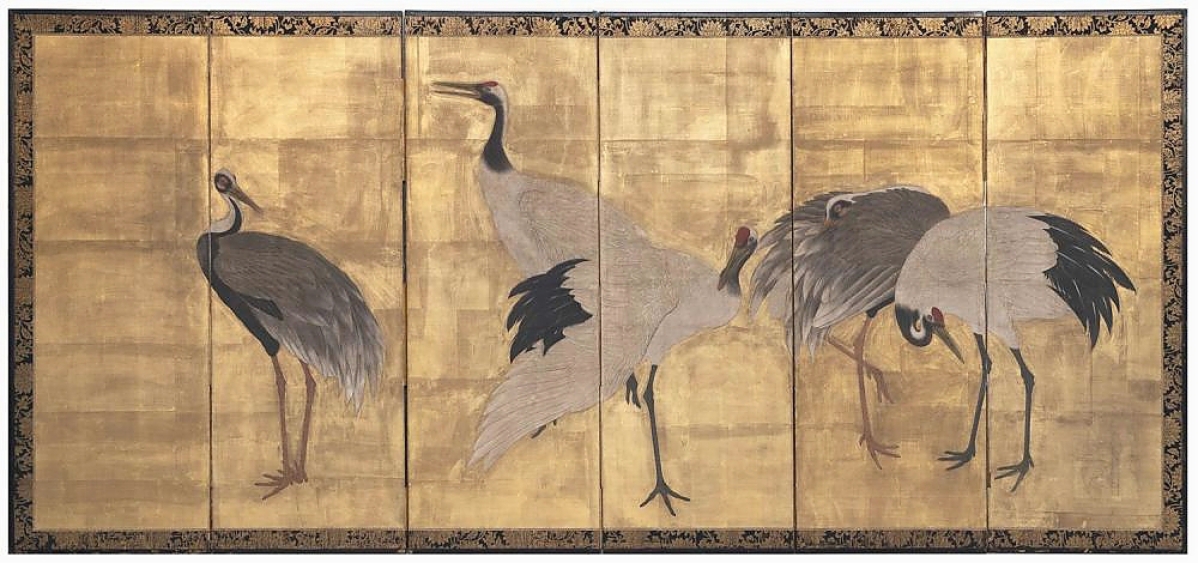
An online bidder from Michigan pushed interest in this Edo period Japanese six-panel screen with cranes to $6,875. It was from the Symmes/Shiro Kuma collection from Atlanta, Ga. ($1,5/2,500).
Furniture was one of the smallest categories on offer but a few lots brought enough interest to bump prices into higher levels. A Nineteenth or Twentieth Century Chinese Huanghuali yoke-back armchair had been consigned by a local seller but sold for $5,000 to a buyer, bidding online, from Singapore. Lejoie said she was not surprised at the result, noting that while it was later than many she sees, it was in good condition and had a good form. She was surprised, however, at the result achieved for a late Nineteenth Century Chinese export hardwood display cabinet that had heavily carved panels. Estimated at $500/800, it brought $1,875 from a buyer in California who was bidding online.
A few lots of Asian textiles knitted enough interest to exceed expectations. Bringing $4,688 from an Ann Arbor, Mich., online bidder was a lot of 11 Nineteenth and Twentieth Century Chinese silk embroidered textiles that included a pair of sleeve bands, a Mandarin square that had been mounted as a purse, three figural panels, three figural roundels and a figural landscape. A slightly smaller lot – this of only six pieces of Chinese silk embroidered textiles – sold to an Oregon buyer for $2,750. It had come from a private estate and featured a robe, jacket, skirt, pants, a threadwork panel and another panel.
Prices quoted include the buyer’s premium as reported by the auction house.
Eldred’s next Asian sales will take place in September; specific dates have yet to be announced.
For more information, 508-385-3116 or www.eldreds.com.






























